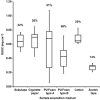Effect of ethnicity, gender and age on the amount and composition of residual skin surface components derived from sebum, sweat and epidermal lipids
- PMID: 23865719
- PMCID: PMC4285158
- DOI: 10.1111/srt.12091
Effect of ethnicity, gender and age on the amount and composition of residual skin surface components derived from sebum, sweat and epidermal lipids
Abstract
Background/purpose: The superficial layer on the skin surface, known as the acid mantle, comprises a mixture of sebum, sweat, corneocyte debris and constituents of natural moisturizing factor. Thus, the phrase 'residual skin surface components' (RSSC) is an appropriate term for the mixture of substances recovered from the skin surface. There is no general agreement about the effects of ethnicity, gender and age on RSSC. The aim of this human volunteer study was to evaluate RSSC in relation to ethnicity, gender and age. A suitable acquisition medium for RSSC collection was identified and samples of RSSC were subsequently analysed using gas chromatography-mass spectrometry (GC-MS) and gravimetry.
Methods: A total of 315 volunteers participated in the study from a range of self-declared ethnic backgrounds. Six acquisition media were compared to determine the most suitable media for RSSC collection. The effect of age, gender and ethnicity on RSSC collection was evaluated by gravimetric analysis while GC-MS was used to determine the composition of RSSC.
Results: Of the six candidate materials assessed, cigarette paper provided the most practical and reproducible sample acquisition medium. There was no significant difference in the amount of RSSC collected when based on gender and ethnicity and no significant correlation between RSSC recovery and age. Up to 49 compounds were detected from human RSSC when analysed by GC-MS.
Conclusions: The results of the present study suggest that RSSC can be effectively collected using cigarette paper and analysed by GC-MS. Ethnicity, gender and age had no significant impact on the quantity of RSSC recovered from the skin surface.
Keywords: age; cigarette paper; ethnicity; gas chromatography-mass spectrometry; gender; sebum; skin surface lipids.
© 2013 The Authors. Skin Research and Technology published by John Wiley & Sons Ltd.
Figures






Similar articles
-
Sebomic identification of sex- and ethnicity-specific variations in residual skin surface components (RSSC) for bio-monitoring or forensic applications.Lipids Health Dis. 2018 Aug 21;17(1):194. doi: 10.1186/s12944-018-0844-z. Lipids Health Dis. 2018. PMID: 30131075 Free PMC article.
-
Age-related differences in morphological characteristics of residual skin surface components collected from the surface of facial skin of healthy male volunteers.Skin Res Technol. 2017 May;23(2):212-220. doi: 10.1111/srt.12321. Epub 2016 Jul 18. Skin Res Technol. 2017. PMID: 27427161
-
Application of sebomics for the analysis of residual skin surface components to detect potential biomarkers of type-1 diabetes mellitus.Sci Rep. 2017 Aug 21;7(1):8999. doi: 10.1038/s41598-017-09014-6. Sci Rep. 2017. PMID: 28827705 Free PMC article.
-
Skin Surface Sebum Analysis by ESI-MS.Biomolecules. 2024 Jul 3;14(7):790. doi: 10.3390/biom14070790. Biomolecules. 2024. PMID: 39062504 Free PMC article. Review.
-
Dissolution of materials in artificial skin surface film liquids.Toxicol In Vitro. 2006 Dec;20(8):1265-83. doi: 10.1016/j.tiv.2006.05.011. Epub 2006 Jun 15. Toxicol In Vitro. 2006. PMID: 16860531 Review.
Cited by
-
Human skin triglycerides prevent bed bug (Cimex lectularius L.) arrestment.Sci Rep. 2021 Dec 8;11(1):22906. doi: 10.1038/s41598-021-01981-1. Sci Rep. 2021. PMID: 34880281 Free PMC article.
-
An Analysis of Foams Produced from Recycled Polyolefins and Low-Cost Foaming Agents: Benchmarking Using Pore Size, Distribution, Shear Effects, and Thermal Properties.Polymers (Basel). 2025 May 6;17(9):1270. doi: 10.3390/polym17091270. Polymers (Basel). 2025. PMID: 40363054 Free PMC article.
-
Working Up a Good Sweat - The Challenges of Standardising Sweat Collection for Metabolomics Analysis.Clin Biochem Rev. 2017 Feb;38(1):13-34. Clin Biochem Rev. 2017. PMID: 28798503 Free PMC article. Review.
-
No skin off your back: the sampling and extraction of sebum for metabolomics.Metabolomics. 2023 Mar 24;19(4):21. doi: 10.1007/s11306-023-01982-3. Metabolomics. 2023. PMID: 36964290 Free PMC article. Review.
-
Surface Wettability for Skin-Interfaced Sensors and Devices.Adv Funct Mater. 2022 Jul 4;32(27):2200260. doi: 10.1002/adfm.202200260. Epub 2022 Apr 28. Adv Funct Mater. 2022. PMID: 36176721 Free PMC article.
References
-
- Williams A. Transdermal and topical drug delivery: from theory to clinical practice. London, UK: Pharmaceutical Press London; 2003.
-
- Chilcott R. Cutaneous anatomy and function. In: Chilcott R, Price S, editors. Principles and practice of skin toxicology. West Sussex, England: Wiley Online Library; 2008. pp. 4–16.
-
- Clarys P, Barel A. Quantitative evaluation of skin surface lipids. Clin Dermatol. 1995;13:307–321. - PubMed
-
- Wertz PW, Michniak BB. Sebum. In: Elsner P, Maibach HI, editors. Cosmeceuticals: drugs vs. cosmetics. New York: Marcel and Dekker Inc; 2004. pp. 45–56.
-
- Stewart ME, Downing DT. Measurement of sebum secretion rates in young children. J Invest Dermatol. 1985;84:59–61. - PubMed
MeSH terms
Substances
LinkOut - more resources
Full Text Sources
Other Literature Sources
Medical
Miscellaneous

